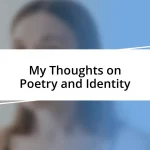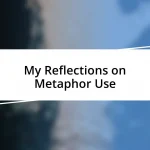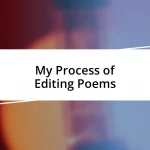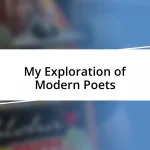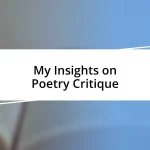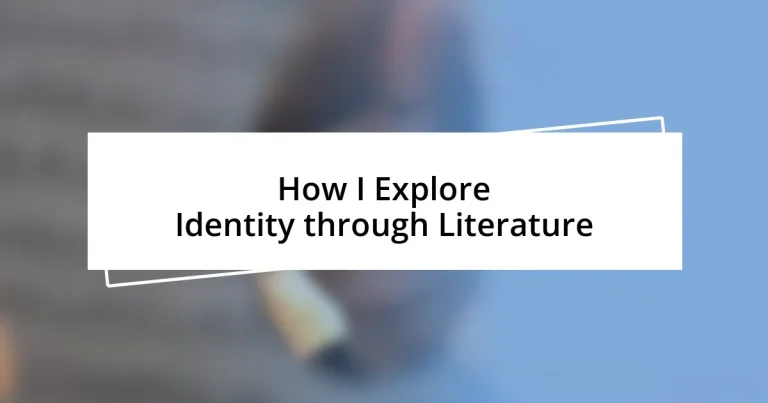Key takeaways:
- Literature serves as a powerful tool for exploring identity, reflecting personal struggles and cultural complexities.
- Analyzing diverse characters, like Holden Caulfield and Elizabeth Bennet, offers insights into themes of alienation, authenticity, and individuality.
- Engaging with various narratives enhances understanding of one’s own identity and the influence of cultural backgrounds.
- Practical exercises, such as journaling and character sketches, promote self-exploration and deepen connections to literary themes.
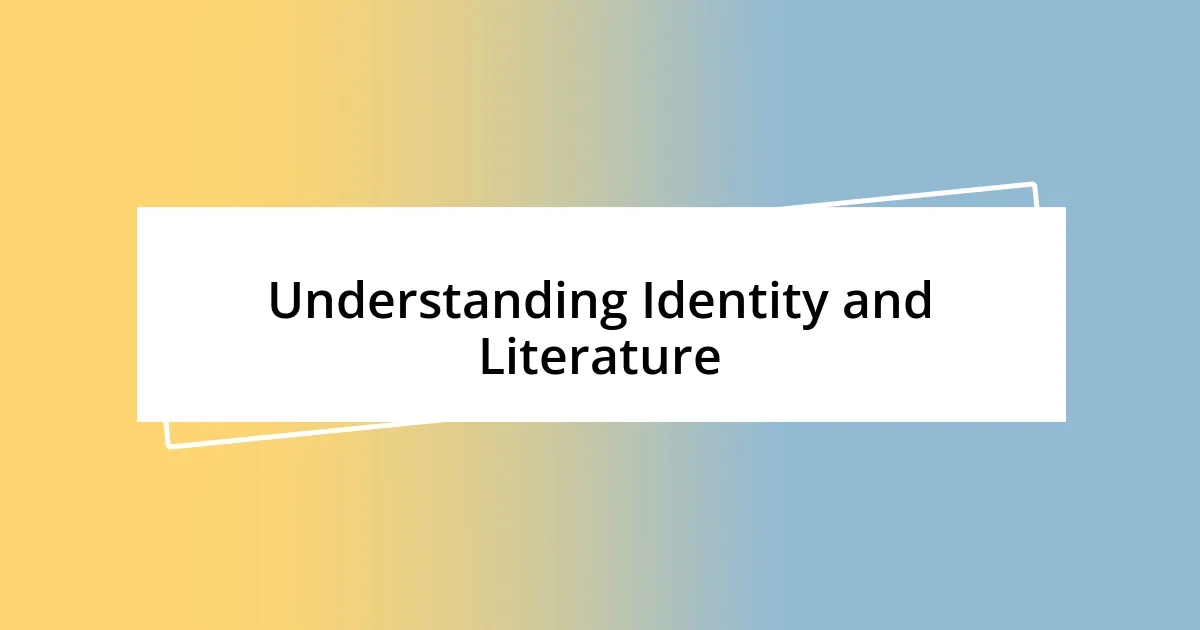
Understanding Identity and Literature
Identity is a complex tapestry, and literature serves as a unique lens through which we can examine it. I recall reading “The Namesake” by Jhumpa Lahiri; it struck me as a powerful reflection of cultural dislocation and the quest for belonging. Have you ever found a character that mirrored your own struggles? It’s profound how fiction can encapsulate such deep aspects of our selves.
When I immerse myself in literature, I often discover pieces of my own identity woven into the narratives and experiences of diverse characters. For instance, Zadie Smith’s “White Teeth” opened my eyes to the multiplicity of identity and the idea that who we are is often a blend of influences from our family histories and cultural backgrounds. Isn’t it fascinating how a book can hold a mirror up to our lives and provoke introspection?
Literature doesn’t just tell stories; it explores the nuances of identity, challenging us to reflect on our own. One winter evening, I found comfort in reading Maya Angelou’s poetry. The cadence of her words about struggle and resilience resonated deeply, making me question how much of my identity is shaped by the challenges I face. Have you felt that connection between your life experiences and the themes in literature? It’s a reminder that our stories are interconnected, and through reading, we can better understand the intricate layers of who we are.
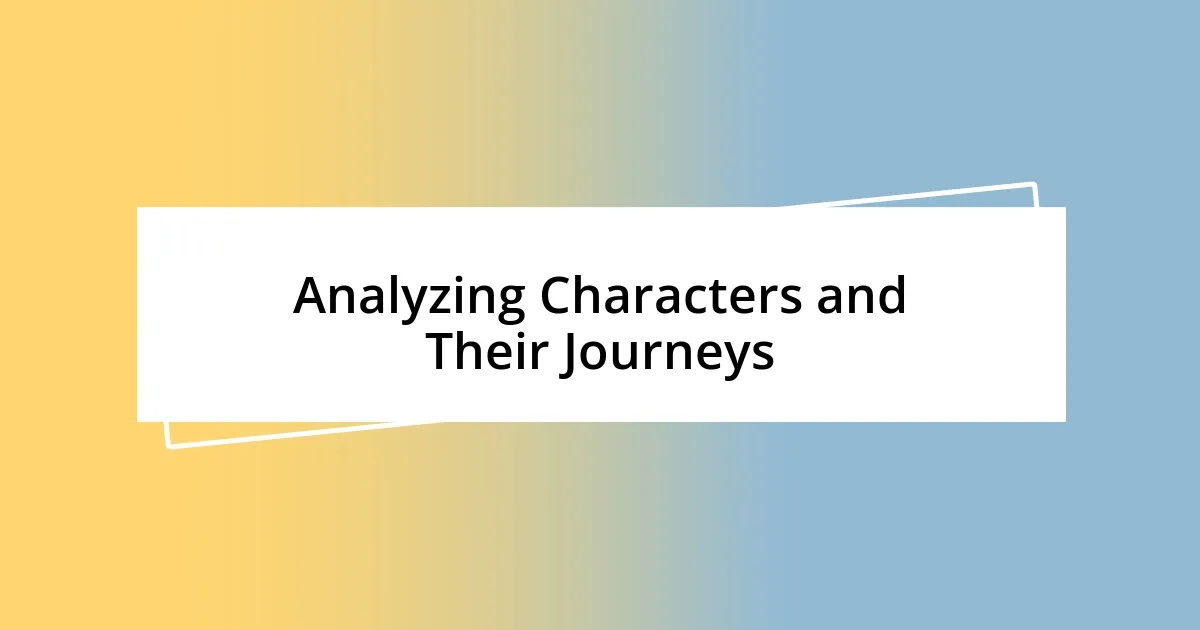
Analyzing Characters and Their Journeys
Analyzing characters in literature offers a compelling way to explore the complexities of identity. Take Holden Caulfield from J.D. Salinger’s “The Catcher in the Rye.” His journey through alienation and his struggle to find authenticity resonate with anyone who has faced the challenges of self-discovery. I’ve often found myself in moments where I felt just as lost, reflecting on what it means to be genuine in a world filled with expectations.
In contrast, look at Elizabeth Bennet in “Pride and Prejudice” by Jane Austen. Her journey of overcoming societal pressures and embracing her individuality speaks to the ongoing negotiation of identity we all face. I remember feeling empowered by her determination to assert herself, and it sparked a powerful realization in me about the value of standing firm in my beliefs despite external demands.
Characters often symbolically represent our inner conflicts and desires. Think about Santiago from “The Alchemist” by Paulo Coelho, whose quest for personal legend aligns with our search for purpose. Each page of his journey reminds me of my own aspirations—ever wondering if I’m truly pursuing what fulfills me? Engaging with these characters isn’t just about following their narratives; it’s an invitation to reflect on our paths and the choices that shape our identities.
| Character | Literary Work | Identity Theme |
|---|---|---|
| Holden Caulfield | The Catcher in the Rye | Alienation and Authenticity |
| Elizabeth Bennet | Pride and Prejudice | Individuality vs. Societal Expectations |
| Santiago | The Alchemist | Personal Legend and Purpose |
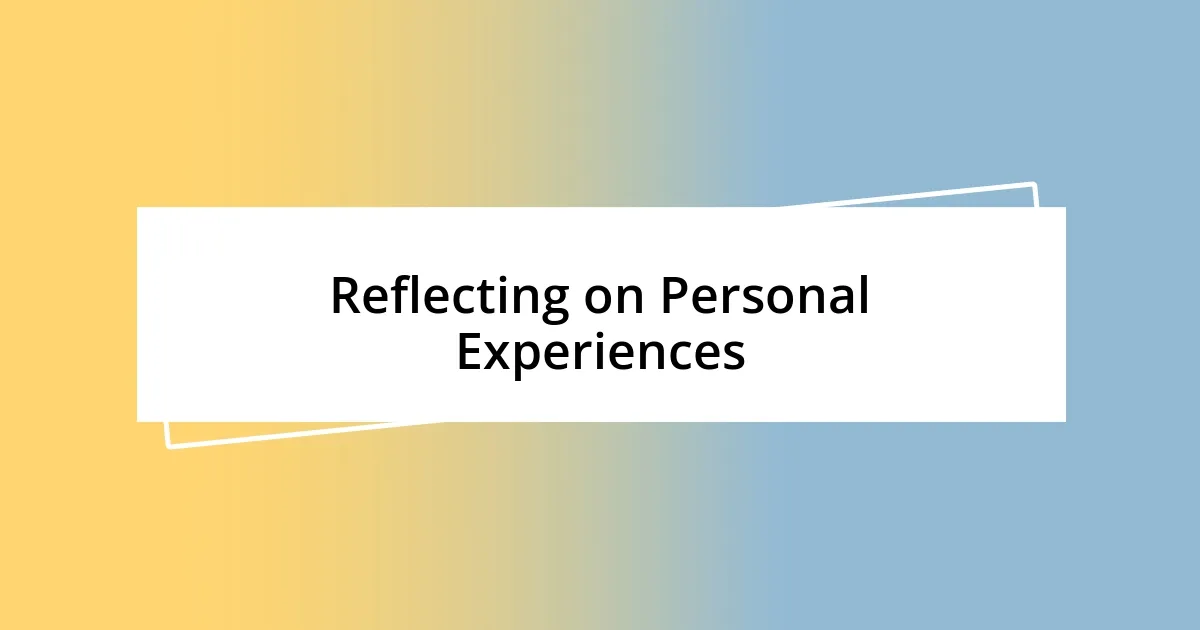
Reflecting on Personal Experiences
Reflecting on personal experiences while reading is often a journey of self-discovery for me. I remember feeling an unexpected surge of emotion when I came across a passage in “The Bell Jar” by Sylvia Plath. As I navigated my own struggles with mental health, Esther Greenwood’s candid portrayal of depression echoed my feelings in a way that was both haunting and illuminating. I realized then how literature can transform pain into shared understanding, creating a sense of solidarity in our individual battles.
- Revisiting a character that faced identity crises has made me reconsider my own choices.
- Moments of laughter or tears while reading often reveal hidden parts of my identity.
- Emotions stirred in me through literature frequently prompt discussions about who I am becoming.
Through these reflective readings, I uncover layers of my identity that I might have previously overlooked. I can vividly recall reading “Beloved” by Toni Morrison and feeling a heart-wrenching connection to the themes of memory and trauma. It pushed me to think about how our past shapes our present. Each narrative adds nuance to my understanding of self, often leaving me questioning how much of my identity is influenced by both personal experiences and collective histories.
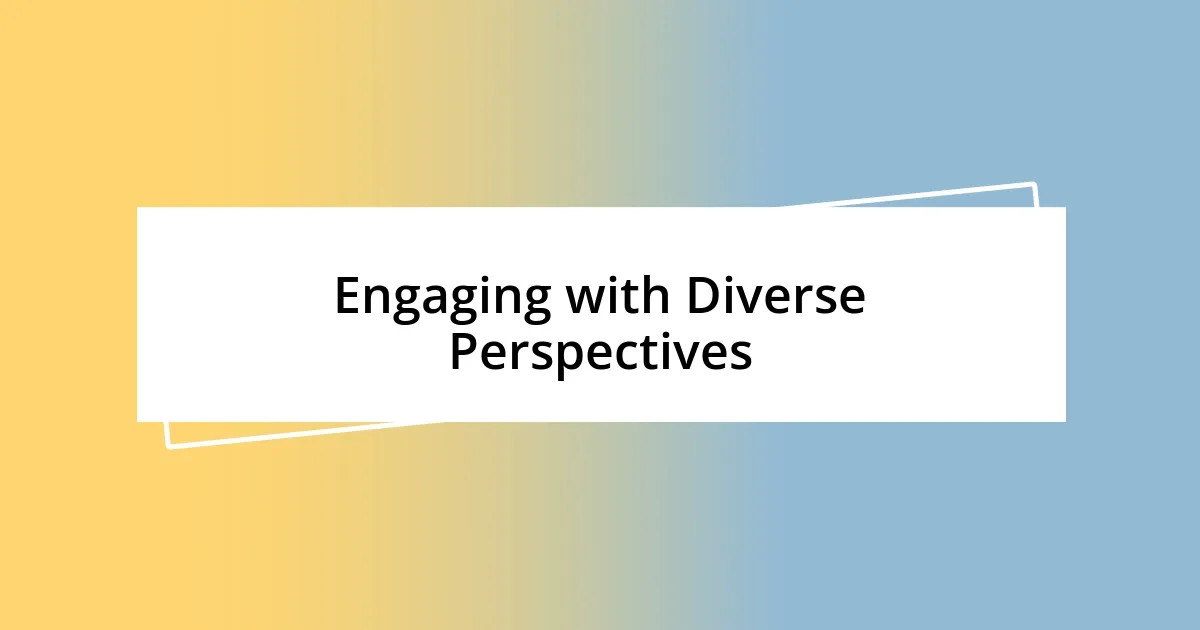
Engaging with Diverse Perspectives
Engaging with diverse perspectives in literature opens a window to lives vastly different from my own. I vividly recall reading “The Kite Runner” by Khaled Hosseini, where the experiences of Amir and Hassan challenge my understanding of friendship and betrayal. Their story forced me to reflect on my relationships and the cultural factors that influence our ties. How often do we really consider the complexities that shape someone else’s actions?
When I encountered the multifaceted identities in “Things Fall Apart” by Chinua Achebe, I couldn’t help but feel a mix of sadness and admiration. The struggles of Okonkwo, as he navigates the changing landscape of colonialism, resonated with my own feelings of cultural displacement at times. It was a powerful reminder that identity is not just shaped by personal choices but also by external forces. I wondered, how does my cultural background inform my identity in today’s world?
Reading “The Joy Luck Club” by Amy Tan brought forth a myriad of emotions as I delved deep into the lives of Chinese immigrant mothers and their American-born daughters. The generational conflict struck a chord with me, as I often find myself balancing the expectations of my heritage with my own dreams. Have you experienced that push and pull between what’s expected of you and what you truly desire? This interaction with diverse narratives has illuminated the inherent richness in our identities, making me appreciate the nuances that come with every story shared across cultures.
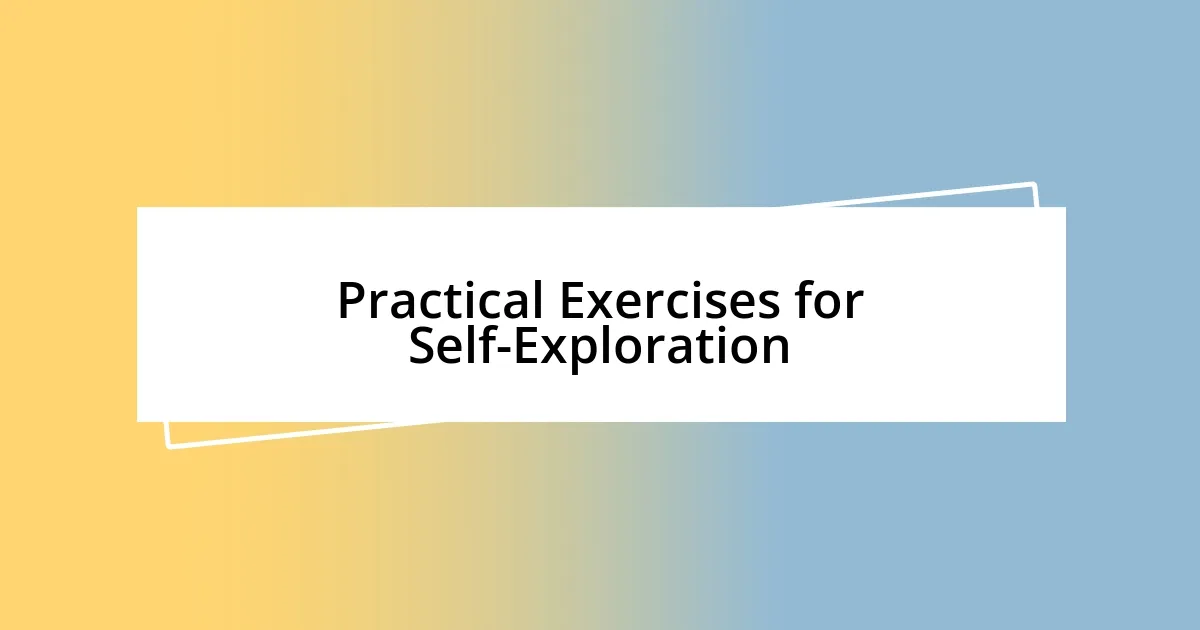
Practical Exercises for Self-Exploration
One practical exercise I find effective for self-exploration through literature is journaling my responses to specific readings. After finishing “The Alchemist” by Paulo Coelho, I spent an afternoon penning my thoughts on the theme of pursuing one’s personal legend. In doing so, I uncovered not only my aspirations but also the fears that were holding me back. How often do we let our dreams slip away because of self-doubt? This practice allows me to anchor my thoughts, revealing parts of myself that I may not have openly acknowledged.
Another approach I enjoy is creating character sketches of protagonists I connect with. While reading “The Catcher in the Rye” by J.D. Salinger, I found myself fascinated by Holden Caulfield’s rebellious nature. I took time to draw parallels between his struggles and my journey through adolescence, shaping a character outline that mapped both his traits and my own insecurities. How does naming these feelings in a fictional character help us recognize them in ourselves? This exercise highlights shared human experience, enhancing my understanding of identity’s fluidity.
Additionally, I often compile a reading list focusing on themes that resonate with my current self-exploratory journey. Recently, I curated a selection of memoirs that challenge societal norms, such as “Educated” by Tara Westover. This not only broadened my perspective but also encouraged me to question the narratives I’ve accepted about family and education. Have you ever considered how your reading choices reflect your evolving identity? Engaging with literature in this intentional way can help illuminate the aspects of ourselves that we are ready to embrace or challenge.
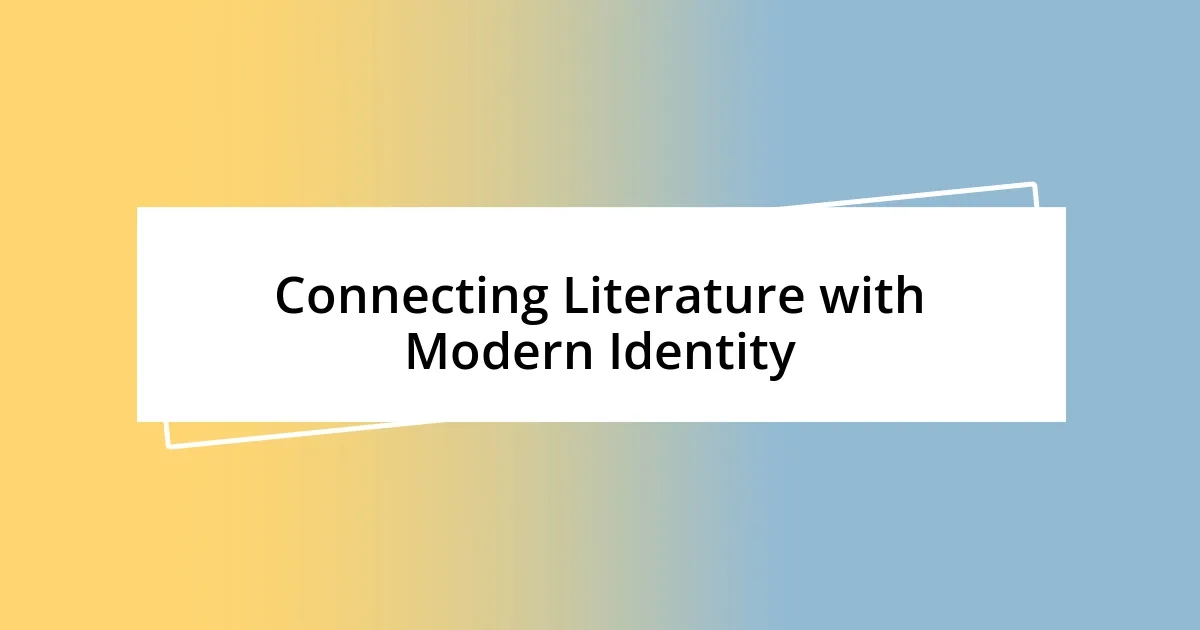
Connecting Literature with Modern Identity
I’m captivated by how literature can serve as a mirror reflecting our modern identity. For instance, after reading “The Hate U Give” by Angie Thomas, I found myself re-evaluating my thoughts on race and social justice. It prompted me to ask, how do the societal issues portrayed in literature resonate with my daily experiences? The rawness of Starr’s story struck a chord deep within me, reminding me that our identities are inevitably shaped by the world around us.
In my explorations, I remember grappling with the themes of belonging and isolation after finishing “Eleanor Oliphant Is Completely Fine” by Gail Honeyman. Eleanor’s struggles with loneliness illuminated my own feelings during my transition to a new city—a time when I questioned my place in a seemingly unfamiliar society. Why do we sometimes feel invisible, even among crowds? Her journey pushed me to confront my vulnerabilities and embrace the idea that identity is often a complex tangle of connection and solitude.
Engaging with contemporary poetry has also enriched my understanding of modern identity. Collections by poets like Rupi Kaur often capture fleeting emotions that resonate with my own experiences. One particular poem about self-acceptance caused me to reflect on my journey of reconciling past insecurities. How can a few lines on a page evoke such profound recognition? It’s remarkable how these simple yet powerful expressions help us navigate our identities and form connections with others.




